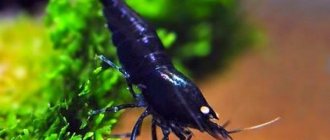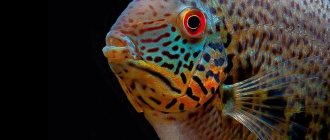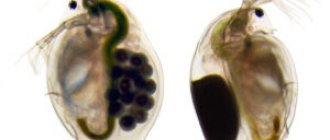Diet
In their natural environment, tiger giants most often eat fish and small mammals, although they do not refuse plant food or detritus. With such size and needs, they have to eat a lot often, so goliaths can be called omnivores. When keeping an aquarium, it is recommended that the hydrocin diet consist of the following products and feeds:
- live fish;
- minced meat and fish;
- shrimp;
- fish fillet.
Initially, until the individuals have fully adapted to the new conditions, they feed only on live food. However, later they happily eat frozen food and even artificial food. Young animals do not refuse flakes, but as they grow older, pellets and granular formulations are introduced into their diet.
What does a tiger shark eat?
Photo: Tiger shark
She is completely indiscriminate in food and is able to eat anyone and anything.
The basis of its menu is:
- sea lions and seals;
- turtles;
- crustaceans;
- squid;
- birds;
- octopuses;
- fish, including other sharks, are no strangers to cannibalism.
Her appetite is truly brutal, and she is hungry most of the day. Moreover, even if she has just eaten a hearty meal, if the opportunity arises, she still cannot resist biting something floating nearby, if she has not tried this before.
“Something” - because it applies not only to animals, but also to any garbage. Many strange objects were found in the stomachs of tiger sharks: car tires and fuel cans, deer antlers, bottles, explosives - and many other similar things.
We can say that this is curiosity: a tiger shark is always interested in what a previously unseen object tastes like and whether it is edible at all. If there is no regular food nearby, instead of a long search, tiger sharks attack those who are: for example, dolphins or crocodiles.
They can even attack animals larger than themselves, for example, whales, if they are wounded or sick and cannot resist. Danger threatens not only small whales, but also large ones - for example, in 2006, a case was recorded of an attack on a humpback whale by a whole group near Hawaii.
Their jaws are powerful and wide, which allows them to cope with even such prey. But for the most part, their menu still consists of small organisms. They also eat carrion. The tiger shark is also capable of eating humans - this is one of the most dangerous species, since they can deliberately hunt people.
Description
The average body length is 132 cm and weight is 30 kg. The maximum length is 180 cm. The body is elongated and fusiform; with age, the dorsal part rises upward due to the development of the adipose fin. The head is large and massive. The eyes are large, providing excellent vision. Sexual dimorphism is weakly expressed. Males are slightly larger than females.
Read also: How to make a mayonnaise mesh
The color is predominantly bluish. The back is darker than the belly. The stripes along the body are faintly visible or absent altogether. The caudal fin is large and forked. In juveniles it is pink or has a red edge.
The lower jaw protrudes forward. The mouth contains 32 sharp, needle-shaped triangular teeth, the sides of which are sharp as blades. Their length reaches 3.5 cm. The upper jaw has two joints that allow the mouth to open very wide.
Large tiger fish are kept in marine pools. In Paris, it can be seen in the Tropical Aquarium at the Porte Doré Palace. The pleasure will cost 19.5 euros.
Feeding is done using special tweezers only with live fish 3-4 times a week. It has not yet been possible to obtain offspring in captivity.
The tiger goliath is considered one of the most dangerous freshwater fish today, second only to piranhas in bloodthirstiness. This type of fish is found in Africa. There are known cases of tiger goliaths attacking crocodiles. The length of the predator reaches 180 cm, weight - more than 50 kilograms.
Despite the obvious threat posed by representatives of this species of fish, in Africa tiger fish are the subject of sport fishing. In the photo: Jeremy Wade, 52, an angler and expert on unusual freshwater fish, hosts River Monsters with his trophy of a tiger fish.
To catch such a large representative of predatory fish, Jeremy spent 8 days in remote places of the Congo River waiting for his catch.
Fishing for river monster
Goliath fish is considered the most dangerous and terrible freshwater fish, and fishing for it is equivalent to hunting a bear. In this regard, many local fishermen practice catching this monster and consider it a kind of duty. In addition to local fishermen, every year many amateur fishermen from all continents come to the banks of the Congo River to “tickle” their nerves and test themselves in extreme conditions. This kind of fishing is a real, sometimes dangerous adventure. Despite this, Goliath fish is a coveted trophy for any angler.
Still, catching a tiger fish is not so easy, since its sharp teeth can bite through fishing line of any diameter. Therefore, fishing is carried out using durable leashes made of steel and other materials. This is the only way to count on success. You should prepare for this type of fishing in advance and carefully.
Jeremy Wade, who is an expert on river fish species and host of the TV program "River Monsters", managed to catch this giant predator. And this is all thanks to experience, since this person has been fishing since childhood. During his 52 years of life, he managed to visit various parts of our planet, where he managed to catch unusual representatives of the underwater world.
To catch the much-coveted prey, the monster hunter had to spend more than a week visiting the most inaccessible places of the Congo River. He was rewarded for his stubbornness, and he came across a fish weighing 70 kg and up to one and a half meters long.
In the photo you can see what kind of giant Jeremy caught. The photo also shows what powerful teeth and what a huge mouth this huge predator has. All that remains is to admire the experience and fearlessness of this man. What is it worth to visit such difficult conditions of the Congo River, when dangerous surprises await you at every step?
River Monsters – Goliath Fish Watch this video on YouTube
Features of catching a predator
Fishing for tiger goliath is very popular. Fishing is carried out by local residents and tourists. Massive catching, as well as poisoning of vegetation in water bodies with chemicals, has reduced the number of this species.
The predator is cunning and deadly, along with the shark.
Mbenga can bite through any fishing line with his teeth. Knowledgeable fishermen use special eyeliners made of durable steel.
This is the only way to catch a giant.
It is advisable to fish together with someone. This will make things easier. One fisherman pulls out the catch, and the second grabs it with a large net. They catch with live bait. In many cases, a fish may bite the bait without being caught. Fishing characteristics:
- fish bite in the morning, afternoon and evening;
- periodically change the place of delivery;
- use a large oscillating rod in black, red and gold shades.
Jeremy Wade managed to catch the giant.
He is a freshwater fish expert who has been fishing since an early age.
Having visited different parts of the planet, he caught different representatives of fresh water bodies. To catch the goliath, the fisherman had to navigate hard-to-reach places in the river.
Wade wanted to admire and release the fish, but due to the heavy struggle during the catch, it lost a lot of strength as it hit the rocks. Goliath was brought to the village and a feast was held.
This is interesting: Three-spined stickleback: description of the fish and its way of life
Description of Goliath fish
This truly huge river monster has several names:
- goliath fish,
- big tiger fish
- giant hydrocin
- Mbenga (that's what local fishermen call this giant). - a species of large predatory ray-finned fish of the African tetra family from Central Africa.
Its Latin name literally means “giant water dog.”
Appearance
This fish grows up to 180 centimeters in length and weighs up to 50 kilograms. This predator has 32 teeth (8 on each jaw), which look very similar to fangs. With the help of its fang teeth, this fish rips whole pieces out of its victims.
The goliath fish has a huge mouth, and its powerful elongated body with small pointed fins is covered with large silver scales, which sometimes shimmer with a golden color. Its lifespan is about 12-15 years. Males are usually larger than females.
Breeding
It’s easy to guess that they are not bred in an aquarium; mostly fry are caught in natural reservoirs and raised.
In nature, they spawn over just a few days, during the rainy season, in December or January. To do this, they migrate from large rivers to small tributaries.
The female lays a large number of eggs in small places, among dense vegetation.
Thus, the hatched fry live in warm water, among an abundance of food, and over time, they are carried out into large rivers.
Goliath fish (lat. Hydrocynus goliath) or large tiger fish is one of the most unusual freshwater fish, a real river monster, the sight of which makes you shiver. Its Latin name speaks best about it. The word hydrocynus means “water dog” and goliath means “giant”, and all can be translated as giant water dog. And her teeth, huge, sharp fangs speak about her character. This is a large, fierce, toothy fish with a powerful body covered with large, silvery scales, sometimes with a golden tint.
Of course, it is almost impossible to find goliath fish in an ordinary home aquarium, however, they are kept in exhibition aquariums and zoos. The fact is that in nature the giant hydrocin grows up to 150 cm and can weigh about 50 kg. One look at its teeth and you immediately understand that such a fish does not feed on vegetation. This is an active and dangerous predator, it is similar to another well-known predator - the piranha, but unlike it, it is much larger. With his huge teeth, he can tear entire pieces of flesh from the body of his victims.
Catches a bird in flight:
It is a pity that its size does not allow keeping tiger fish in a home aquarium; it is only suitable for huge volumes, from 3000 liters. In fact, it is quite unpretentious and the only difficulty in keeping it is the volume and large amount of food required for goliath fish.
In Africa, fishing for goliath fish is extremely popular both among local residents and as entertainment for tourists.
https://youtube.com/watch?v=wLsEY2SQIZw
The African big tiger fish can reach a body length of 150 cm and weigh up to 50 kg. Size data constantly varies, but this is understandable; fishermen cannot help but boast. However, these are record specimens even for nature, and in an aquarium it is much smaller, usually no more than 75 cm. Its lifespan is about 12-15 years.
It has a strong, elongated body with small, pointed fins. The most impressive thing about the appearance of the goliath fish is its head: large, with a very large mouth, with large, sharp teeth, 8 on each jaw. They serve to grab and tear the victim, and not for chewing, and during life they fall out, but new ones grow in their place.
Goliaths definitely cannot be called a fish for a home aquarium; they are kept only in commercial or species aquariums. In fact, they are not difficult to maintain, but their size and gluttony make them practically inaccessible to amateurs. Although, juveniles can be kept in a regular aquarium, however, they grow very quickly and will then need to be disposed of.
In nature, the tiger fish mainly feeds on fish and small mammals, although this does not mean that it does not eat plant matter and detritus. Having such sizes, they do not disdain anything. So it is rather an omnivorous fish. In an aquarium, it needs to be fed with live fish, minced meat, shrimp, and fish fillets. At first, they eat only live food, but as they acclimatize, they switch to frozen and even artificial food. Juveniles even eat flakes, but as they grow they need to switch to pellets and granules. However, if you feed live food frequently, they will begin to refuse others, so the diet should be mixed.
Large tiger fish, goliath, mbenga, giant hydrocine - all these are the names of one individual native to Africa. This is a freshwater monster, which is also called the “water dog”.
He has huge teeth (32 pieces), sharp fangs. The fish is very fierce, with a powerful body and silvery scales. It is kept in exhibition zoos and commercial aquariums. The predator grows up to 1.5 m and weighs 50 kg. Outwardly it resembles a piranha, only larger.
Appearance of individuals
Despite the fact that from the lips of boastful fishermen you can hear about 5-meter-long goliaths caught with your own hands, the size of these river inhabitants is still impressive. For a river inhabitant, one and a half meters in length is already a lot. In captivity, individuals do not grow more than 75 cm. Individuals live from 12 to 15 years. The description of the individuals is as follows:
- the body is oblong, strong;
- fins are small, pointed, orange or reddish in color;
- the head is large, with a wide mouth, equipped with large, sharp teeth - 32 in total;
- With their teeth, fish grab and tear prey without chewing. These fish have teeth replaced by new ones throughout their lives;
- the body is covered with large scales of silver color with a golden tint.
Diseases
The fish is hardy and unpretentious; if the aquarium is in good condition, then there are no health problems. The main reasons for decreased immunity are lack of free space (small aquarium) and poor quality food. Since the fish feed on live food, there is a risk of infection through sick prey fish. Read more about symptoms and treatment methods in the section “Diseases of aquarium fish”.
Peculiarities
- Predator
- Requires a huge aquarium
Source
Types of silver carp
There are 3 types of silver carp. 2 of them appeared naturally, and the third was artificially bred by breeders:
- Silver carp.
It has a lighter color, and its head makes up 15-20% of the total body length. It feeds exclusively on algae and, thanks to its gill apparatus, perfectly clears its habitat of duckweed and makes the water clear. Has a habit of jumping out of the water when tapped on its surface. In the USA, there is even crossbow hunting for this type of fish. There are 3 types of silver carp. 2 of them appeared naturally, and the third was bred by breeders - Bigheaded carp. It is also called big-headed due to the fact that the head of the fish of this species makes up almost 50% of the entire length. In addition to plant foods, the diet of the motley species also contains bioplankton. Thanks to this, it grows and develops faster than its white relative.
- Hybrid. Obtained by crossing the two previous species. It has a smaller head compared to its body, and the weight of such a silver carp is greater. This fish is not picky about food and, in addition to phyto- and zooplankton, can consume small crustaceans. It is also highly resistant to low water temperatures.
Living in the natural environment
The first description of individuals was compiled in the 60s of the 19th century. Its habitat is African reservoirs, from Egyptian to South African. More often, goliaths are found in Senegal, the Nile, Congo, and Lake Tanganyika. Since hydrocin is a large fish, large, deep rivers and lakes are most suitable for it. Moreover, representatives of this species are not loners and lead a gregarious lifestyle with their brethren or other large predators.
Goliaths are gluttonous, insatiable and successful in hunting. Their diet includes fish, aquatic animals and even crocodiles. There are several recorded cases where they attacked a person, but experts say that the fish behaved this way by mistake, without considering the “prey”.
The goliath is known locally as "mbenga" and is actively fished for. But, in addition to this, they offer this activity as entertainment to numerous tourists. According to fishermen, it is not easy to catch such a large fish, no matter how strong the fishing line is, it still will not withstand such weight. Therefore, the fishing line is replaced with durable steel leads.
Scientists have been interested in these original creatures for a long time; studies have shown that they are contemporaries of dinosaurs. In nature, where hydrocines live, it is difficult to survive, so individuals actively evolved until they turned into dangerous, predatory creatures. Although goliaths have fewer enemies in nature, humans remain the greatest threat to them.
He is engaged in massive catching of this fish, poisoning coastal vegetation with chemicals, polluting the aquatic environment, which leads to a steady decline in the population of giant hydrocines. This state of affairs has attracted the attention of local authorities, environmental services and environmental organizations, who are trying to save such unique river inhabitants from extinction.
Natural enemies of tiger sharks
Photo: Tiger shark fish
Many large predators pose a danger to young and growing individuals, although most are slower. As the threats grow, there are fewer and fewer threats, and adult fish may have practically no fear of anyone. The most formidable enemies are: swordfish, marlin, spiny-tailed and diamondback rays, other sharks, primarily relatives.
But of all the above, only sharks are the first to attack, and this happens rarely, so tiger sharks have few worthy opponents. But this is if we limit ourselves only to those that can measure their strength with them and enter into direct combat, but there are others that are much more dangerous for this fish.
One of the worst enemies of the tiger shark is the hedgehog fish. It is very small and does not attack itself, but if a tiger shark swallows it, then inside the predator this fish becomes a prickly ball and pierces the shark’s insides, which often leads to its death. Another common cause of shark death is parasites.
People also exterminate a large number of them - perhaps it is at human hands that the bulk of these predators die. In this case, everything is fair: the shark is also not averse to feasting on humans - dozens of attacks occur every year, because tiger sharks tend to swim in crowded places.
Interesting fact: The tiger shark is such a picky eater because its gastric juice is very acidic, allowing it to digest a lot of things. In addition, some time after each meal, she simply regurgitates undigested remains - so sharks usually do not suffer from stomach problems. If you haven't swallowed a hedgehog fish.
staying in the aquarium and feeding
Goliath, also called hydrocinus, can be kept in an aquarium. They are not suitable for a home aquarium solely due to their large size and the need for large amounts of food. You can keep young individuals, taking into account the fact that as they grow, you will have to get rid of them.
To keep it in an observation aquarium you need little, since these fish are unpretentious. There will also be no problems with feeding, since the goliath terapon belongs to the category of omnivorous fish. In an aquarium, fish fillets, small fish, shrimp and minced meat are suitable as food . The only requirement is that the diet must be balanced.
Interesting fact! Photographs were taken that show the goliath catching birds in flight that fly low over the water. That is, this fish has the ability to jump out of the water for a short period of time to catch prey.
Due to its habit of living in packs, the giant goliath requires a lot of free space in the aquarium. The minimum size of the latter must be at least 3000 liters. In addition, it is necessary to take care of a good filtration system, since fish have a habit of tearing food apart when eating, which contributes to water pollution. In the wild, the African goliath is accustomed to living in rivers with strong currents, so it must be provided for in the aquarium. It is better to use large stones and driftwood for decorative details, and choose sand for the soil. Algae will be unnecessary.
https://youtube.com/watch?v=fRK8ls34FMo
The nature of the goliath may not necessarily be aggressive, but due to their good appetite, their neighbors in the aquarium can often lose their lives. The best option for a neighborhood is other predators who can protect themselves from their attacks.
Basic data
Due to its rather decent size, keeping goliath in a home aquarium is impossible. However, any zoo or exhibition hall will not refuse to have such an original specimen in its collection that attracts visitors, and they are often found in such aquariums.
In their natural environment, the length of giant hydrocines reaches one and a half meters, and their weight is 50 kg. And at first glance at this fish it becomes clear - this is not a vegetarian, with such and such teeth! Goliath is an agile, dangerous predator, similar to a piranha, only more impressive in size. Using their powerful jaws and razor-sharp teeth, they are able to rip large chunks of meat from their prey.
Of course, exotic lovers dream of such an extraordinary pet. And the goliath itself may well live in captivity. Only it requires a huge, at least 3000-liter aquarium. It is quite undemanding in maintenance, but, in addition to a spacious tank, it requires a lot of nutritious food.
Getting offspring
It is impossible to breed large tiger fish fry in an aquarium. The bulk of the babies are caught in natural reservoirs and raised. In nature, goliath spawning lasts only a few days during the rainy season. To continue the race, individuals migrate from their usual home to small tributaries, where the female lays a huge number of eggs in small, overgrown areas. When the fry appear, they immediately find themselves in warm water with an abundant food supply, and as they grow older, the current carries them into large bodies of water.
Goliath fish attracts the attention of tourists and zoo visitors. This amazing creature has lived on earth for several million years, has gone through centuries of evolution and can withstand many unfavorable factors... But today it depends on man whether such an extraordinary fish will disappear or continue to exist.
Aquarium content
All the requirements of goliaths are mainly related to their impressive size:
- several individuals require a tank with a volume of at least 3000 liters;
- filtration is necessary, and the system must be powerful, capable of creating an intense flow - the goliath in nature prefers to live in fast-flowing rivers, and its habit of tearing food into pieces leads to rapid water pollution;
- These are freshwater fish, so there is no need to add salt to the water;
- Large driftwood, stones, sand can be used as decoration;
- You can do without landscaping the aquarium; in addition, hydrocin needs room for swimming.











